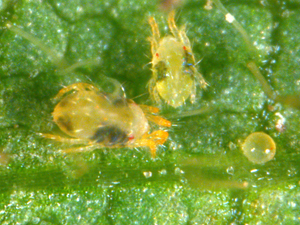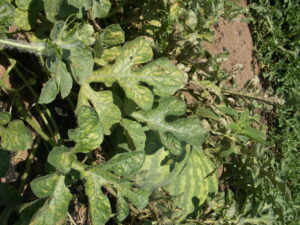Sometimes choosing the right product to manage a particular pest can be a daunting and risky task, especially when crops are close to harvest and an imposing outbreak sneaks up on you. One such pest that is sneaky are two-spotted spider mites (Tetranychus urticae; Figure 1). This microscopic pest can hang out in the crop or neighboring habitat and go unnoticed for a long time, just waiting for the perfect combination of crop growth stage and environmental conditions when it will explode in numbers and become a noticeable threat to the crop.

Figure 1. Adult two-spotted spider mites are distinguished by the two black dots on the dorsal side of their body. Their eggs are small and translucent and can be seen in the figure as well. (Photo by John Obermeyer.)
Here are the facts on spider mites. They have a wide host range, meaning they feed on more than 20 different species of plants. This makes limiting host plant availability as a means of control impossible. They can withstand a variety of environmental conditions and overwinter in sheltered environments in our region (greenhouses, high tunnel, etc.). Their main mechanism of dispersal is on the wind. Eggs are laid on fine silk webbing and under high populations this webbing resembles those produced by spiders, hence the common name. Depending on the environment, they can complete their life cycle in 5-20 days. Generally, the warmer it is the faster they develop. This rapid life cycle leads to an increase in the potential to develop resistance to pesticides applied to manage this pest. Mites feed on the plant at the cellular level, removing photosynthates and creating a stippling pattern on the leaves. This looks like white/yellow speckles on the upper surface of the leaves and on the underside you will see the pest and webbing (Figure 2).

Figure 2. Spider mite damage often causes interveinal chlorosis on older leaves and may be mistaken for a nutritional problem. (Photo by Dan Egel)
The mites thrive in hot and dry weather, and therefore many of you may be noticing them in your crops beginning in July. There are a variety of products available for use to manage this pest, and careful consideration should be made. Below I will discuss four common products that are used in conventional production of cucurbit crops.
Oberon® (spiromesifen) is a contact pesticide effective against all development stages, however juveniles are more susceptible than adults. This product belongs to group 23 insecticides, according to the insecticide resistance action committee (IRAC) mode of action designation. Group 23 are growth inhibitors specifically preventing lipid biosynthesis leading to death. This is why adults are less susceptible, they are not growing nearly as much as the immature stages of this pest. Growth inhibitors can be slow acting; you should wait 4-10 days to evaluate mortality following the application. Thorough coverage is key.
Portal® (fenpyroximate) is a group 21A insecticide. It controls all mobile stages of mites by inhibiting cellular respiration in the mitochondrion of cells resulting in rapid cessation of all biological activities including feeding and reproduction. Feeding stops immediately after application and mortality can be observed within 3-7 days.
Zeal® (etoxale) is a group 10B insecticide, interrupting the production of chitin which is the substance that constitutes the exoskeleton of the pest. It is a growth inhibitor, like spiromesifen, but disrupting a different aspect of the growth process. It is predominately an ovicide (kills eggs) and larvicide (kills immatures). No more than one application per season and 3.0 oz per acre are allowed. Coverage is essential for good control and the water volume in the mix should be increased when making applications to mature plants or those with more compact foliage. Like group 23 products, group 10B is slow acting because it is interrupting development, i.e. progression into the next development stage is disrupted.
Agri-mek® (abamectin) is a group 6 insecticide. Products belonging to this group target nerves and muscles in the insect causing paralysis. This mode is generally fast acting, and you can see results in a short amount of time. Thorough spray coverage is key. Group 6 products are highly toxic to bees and should not be applied during bloom. An adjuvant must be used with application to avoid illegal crop residues.
Be sure to scout your crop and evaluate the level of infestation, development stage of the pest and progress of the crop when choosing a miticide. As always, follow the label directions for whichever product you choose; the label is the law.